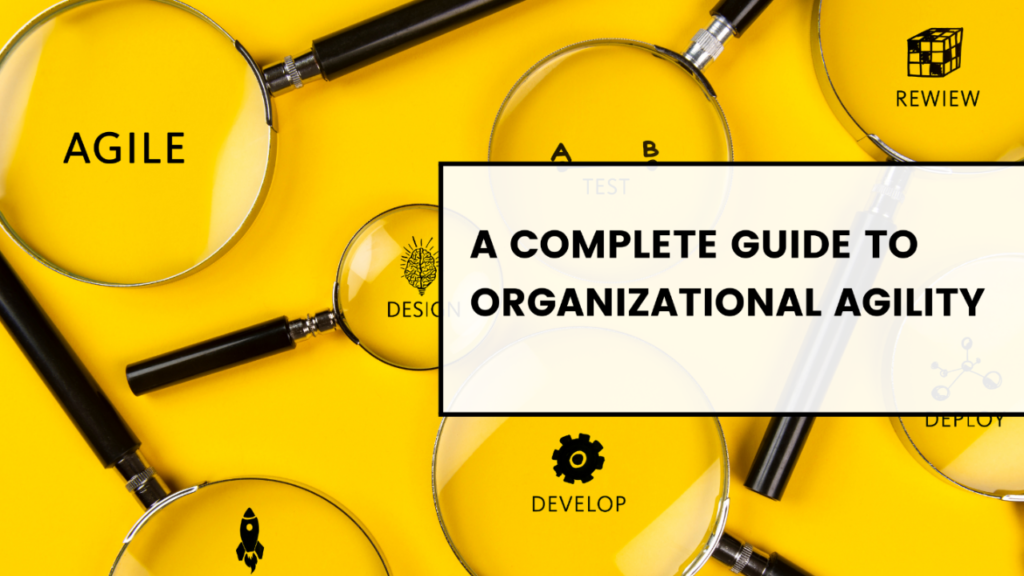Know what is Organizational Agility, what are steps to achieve it, and what are challenges commonly faced.

Have you heard of the term “organizational agility”?
In contemporary, rapid-paced global business, it has become a buzzword for organizations trying to stay ahead of the curve. Simply positioned, organizational agility refers to an organization’s capacity to conform quickly to changing situations and marketplace situations. This includes being flexible in methods, structures, or even techniques. With the ever-increasing tempo of technological advancement, the need for organizational agility has become more important than ever before.
However, achieving organizational agility is more difficult to say than to do. It necessitates a fundamental shift in how an employer operates, from its traditions to its strategies and everything in between. This is where our blog can help! We will break down the fundamentals of agility, the steps required to acquire it, common stressful situations, and hints for overcoming them in this comprehensive guide to organizational agility. We’ll also introduce you to some of the most popular agile methodologies and tools that businesses use to improve their agility.
So, whether you’re an agency owner, a crew chief, or just curious about the challenge, this blog is for you! We hope you find it insightful and informative, and that it inspires you to take the first steps toward building a more agile organization. Let us begin!
The Basics of Organizational Agility
Organizational agility refers to the potential of an organization to quickly adapt to changes within the commercial enterprise environment without dropping momentum or compromising its desires. An agile enterprise is responsive, innovative, and collaborative, with a focus on turning a profit for its clients. To gain organizational agility, businesses need to adopt certain traits, which include flexibility, adaptability, and speed, and continuously evolve and enhance their strategies and practices.
By doing so, they can gain a competitive advantage, improve consumer delight, and acquire higher enterprise results. Additionally, embracing agility can also enhance employee engagement and pleasure because it empowers teams to make decisions and take ownership of their work, resulting in a more pleasant and worthwhile work experience.
Steps to Achieve Organizational Agility
Organizational agility is crucial for agencies to thrive in today’s fast-paced business landscape. However, achieving organizational agility can be hard, specifically for agencies that have been following traditional, hierarchical models for years. In this blog, we will discuss the steps that groups can take to obtain organizational agility.
Step 1: Develop a subculture of agility
Developing a culture of agility is essential to achieving organizational agility. Companies want to create an environment that values flexibility, adaptability, and experimentation. This means encouraging personnel to take risks, learn from mistakes, and be open to change. Leaders have to also model the behaviour they need to see from their personnel, which includes being inclined to pivot when necessary and promoting collaboration throughout departments.
Step 2: Implement Agile frameworks and methodologies
Agile frameworks and methodologies that help businesses become more flexible and adaptable. Implementing Agile frameworks, including Scrum or Kanban, can help groups become more efficient and effective. These frameworks prioritize collaboration, non-stop improvement, and handing over value to customers. Implementing these methodologies requires training and support, but the effects can be transformative for an organization’s agility.
Step 3: Empower teams to make choices
In conventional hierarchical fashions, selections are regularly made by upper management, which may slow down the choice-making procedure and restrict creativity. To attain organizational agility, companies need to empower their groups to make decisions. This involves giving groups the authority to make selections within their areas of expertise and trusting them to do so. By giving groups the autonomy to make selections, corporations can become more nimble and attentive to changes in the market.
Step 4: Foster go-purposeful collaboration
Silos can be damaging to organizational agility. When groups work in isolation, it can be tough to coordinate efforts, share statistics, and respond quickly to modifications. To conquer this assignment, companies need to foster meaningful collaboration. This approach encourages personnel from exceptional departments to work together, share understanding, and collaborate on initiatives. Cross-purposeful collaboration can smash down silos, increase innovation, and enhance the conversation.
Step 5: Embrace innovation and experimentation
Organizational agility requires a willingness to experiment and attempt new things. Companies want to take risks and embody failure as a possibility. This approach encourages personnel to give you new thoughts and permits them to test those ideas without fear of retribution. By embracing innovation and experimentation, agencies can stay ahead of the competition and respond to changes in the marketplace.
Common Challenges in Achieving Organizational Agility
While imposing organizational agility can bring many blessings to a business, accomplishing it could be hard. In this phase, we will take a closer look at a few demanding situations that corporations might also face while looking to grow and become more ethical.
Resistance to Change
One of the most widespread and demanding situations in attaining organizational agility is trade resistance. Change can be tough for human beings, and it can be especially difficult once they sense that their roles or methods of running are being disrupted. Resistance can manifest in special ways, which include scepticism, fear, and outright opposition to new initiatives. Organizations should anticipate resistance and proactively cope with it with the aid by involving employees in the alternate system, communicating the advantages of agility, and presenting schooling and help.
Lack of Support from Leadership
Organizational agility requires buy-in and help from the top down. However, if leadership does not prioritize agility or actively promote it, it could be challenging to gain momentum. Leaders should apprehend the advantages of agility and be inclined to allocate assets and make changes to guide it. They need to additionally be willing to adopt agile behaviors and communicate the importance of agility to the rest of the organization.
Inadequate Resources and Budget
Implementing organizational agility can also require extra resources and finances, which may be a venture for organizations that are already stretched thin. For example, adopting Agile frameworks or making an investment in new technologies may additionally require education, the hiring of new workers, or the purchase of new tools. Organizations need to be cautious, not forget the costs and advantages of agility, and prioritize investments so that they will have the maximum impact.
Difficulty in Implementing New Processes and Methodologies
Implementing new strategies and methodologies can be hard, especially if they are surprising to personnel. For instance, imposing Scrum or Kanban may also require changes to how groups are organized and the way work is controlled. Organizations should offer adequate education and guidance to personnel and make certain that new procedures and methodologies are implemented regularly with clear communication and buy-in from stakeholders.
Limited Knowledge and Expertise
Becoming more agile may additionally require know-how and knowledge that the agency does not currently possess. For instance, implementing DevOps or Design Thinking can also require specialized skills or know-how. Organizations ought to perceive information gaps and invest in training and hiring to build vital capabilities. They can also keep in mind partnering with external specialists or specialists to help fill those gaps.
Becoming more agile isn’t always without its demanding situations. However, with the right know-how and by proactively addressing these demanding situations, groups can triumph over them and attain the numerous blessings that agility can bring.
Master Organizational Agility with ValueX2
Learn how to implement organizational agility from ValueX2’s agile training courses- such as Agility in HR, marketing, etc and prepare your employees for the uncertainties of the modern business world. Discover how to address volatility and dynamism in the market, encourage innovation and promote effective inter-company interaction. Courses taught by industry professionals provide solutions to enhance the performance of organizations using Scrum, Kanban, and Lean, providing guidance that helps the teams generate once-in-a-lifetime successes.
Be the best, make the correct decision, and get the result you need. Ready to get started on the path towards change? Sign up for ValueX2 agile training now and open the door for your business!
Conclusion
In the end, organizational agility is an important factor in the ultra-modern fast-paced, and competitive business panorama. By embracing agile equipment and strategies, businesses can improve their capacity to reply to converting marketplace needs and client needs quickly. The gear and strategies mentioned in this article, which include Scrum, Kanban, Lean, DevOps, and Design Thinking, can assist companies to be greater bendy, efficient, and powerful in their operations.
However, it’s crucial to note that there may be no one-length-suits-all approach to achieving organizational agility. Each organization must determine the tools and strategies which can be most appropriate for its unique situation. By continually monitoring and measuring development, and fostering a subculture of non-stop getting to know and model, businesses can reap organizational agility and hold a competitive facet in their industry.
Frequently Asked Questions (FAQs)
Q. Why is organizational agility important?
Ans. Organizational flexibility has become an essential factor for organizations to sustain their operations and be productive in emerging markets as well as meeting customers’ expectations.
Q. What are the steps to achieve organizational agility?
Ans. Key steps include:
- Building up the organizational agility mindset.
- Increasing value delivery through management of requirements.
- Liberating teams to decide.
- Building cross-sectional communication and cooperation.
- Being open to innovation and experimentation.
Q. What are common challenges faced in achieving organizational agility?
Ans. Amid challenges to organizational agility, there is resistance to change, lack of leadership support, lack of enough resources, implementation issues, and knowledge deficits.
Q. What role does leadership play in organizational agility?
Ans. Senior management facilitates agility because they champion the concept, provide funds, lead by example, and support innovative working in cross-functional teams.
Q. How does organizational agility benefit employees?
Ans. They make employees autonomous in their decision-making, promote teamwork, and creativity, and entice staff to make work a more satisfying experience.







